
- •INTRODUCTION
- •LATER EIGHTY YEARS’ WAR DUTCH
- •LATER IMPERIAL SPANISH
- •EARLY 17TH CENTURY FRENCH
- •THIRTY YEARS’ WAR DANISH
- •EARLY THIRTY YEARS’ WAR GERMAN PROTESTANT
- •HUNGARIAN-TRANSYLVANIAN
- •EARLY CAROLINE ENGLISH
- •EARLY THIRTY YEARS’ WAR SWEDISH
- •LATER THIRTY YEARS’ WAR GERMAN
- •LATER THIRTY YEARS’ WAR SWEDISH AND WEIMARIAN
- •THIRTY YEARS’ WAR FRENCH
- •THIRTY YEARS’ WAR PENINSULAR SPANISH
- •SCOTS COVENANTER
- •SCOTS ROYALIST
- •EARLY RESTORATION PORTUGUESE
- •CONFEDERATE IRISH
- •EARLY ENGLISH CIVIL WAR ROYALIST
- •ENGLISH CIVIL WAR PARLIAMENTARIAN
- •LATER ENGLISH CIVIL WAR ROYALIST
- •NEW MODEL ARMY
- •EARLY LOUIS XIV FRENCH
- •APPENDIX 1 – USING THE LISTS
- •INDEX
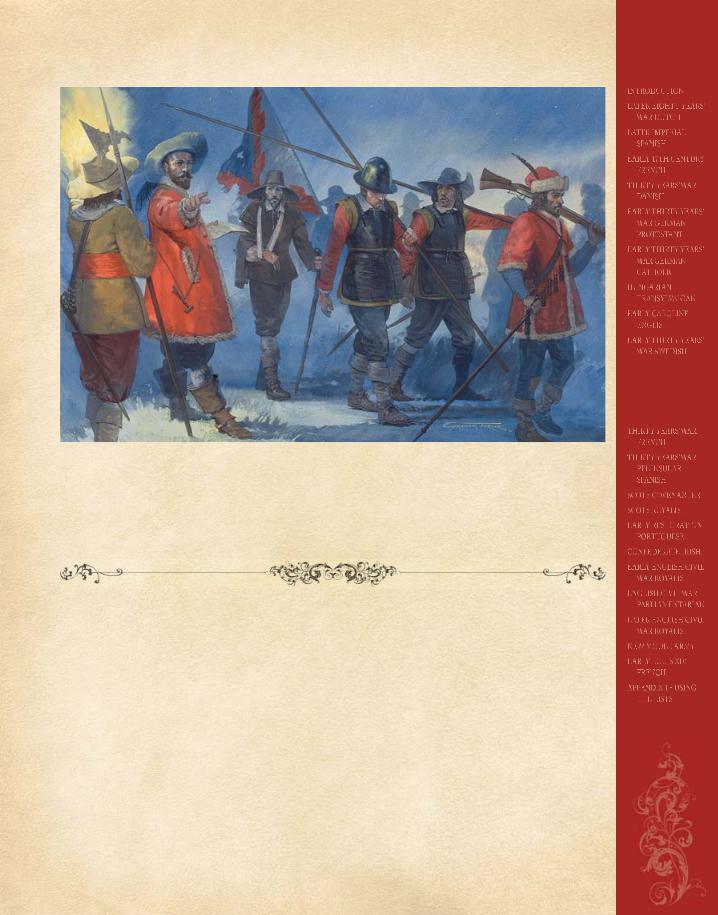
LATER THIRTY YEARS’ WAR SWEDISH AND WEIMARIAN
The Imperial retreat, 1632, by Graham Turner © Osprey Publishing Ltd. Taken from Campaign 68:
Lützen 1632.
LATER THIRTY YEARS’ WAR SWEDISH
AND WEIMARIAN
This list covers Swedish armies from the aftermath of the first battle of Nördlingen in 1634 until the Treaty of
Westphalia in 1648 brought the Thirty Years’ War to an end. It also includes the mercenary army of Bernhard von Sachsen-Weimar (the Weimarians or Bernhardines) in the service of France from 1635 until his death in 1639, and then its continued existence as the French Armee d’Allemagne until it became effectively just a normal French army (albeit with a significant German proportion) in 1644 following catastrophic losses in late 1643.
Following the catastrophic defeat at Nördlingen, the Swedes were forced back into northern Germany, desperately trying to recruit a replacement army with which to defend their Pomeranian possessions.Their situation was made worse as the Emperor agreed the Peace of Prague with the major Protestant powers, one clause of which was the delayed implementation of the Edict of Restitution for 40 years, which effectively meant it was a dead letter. At a stroke German support for Sweden was almost entirely removed. This act, as it significantly bolstered the Habsburg position, effectively forced France into the war.
53
© Osprey Publishing ¥ www.ospreypublishing.com
LATER THIRTY YEARS’ WAR GERMAN
LATER THIRTY YEARS’ WAR SWEDISH AND WEIMARIAN
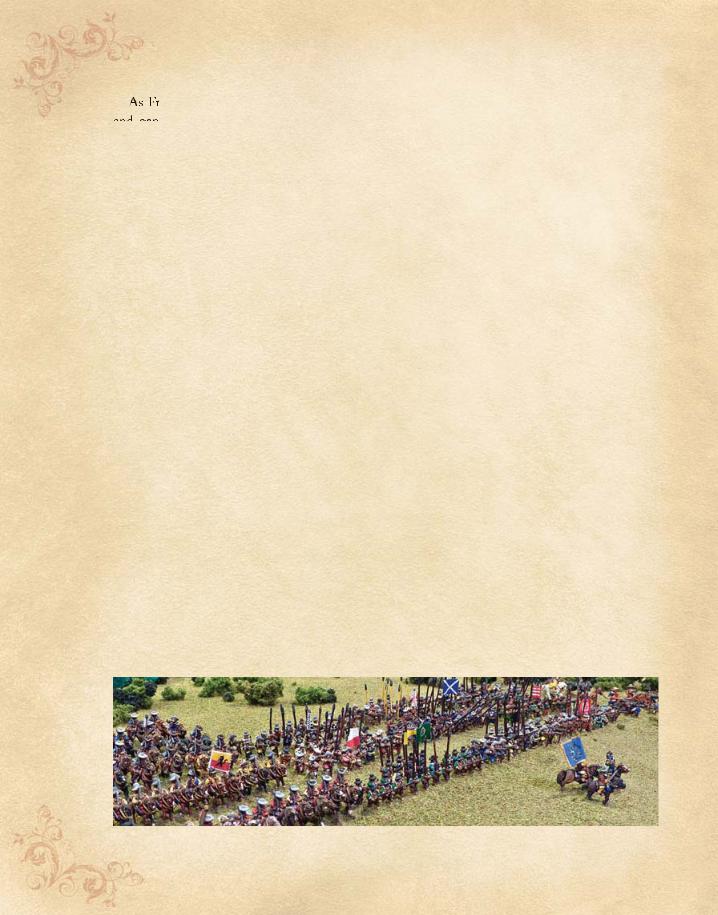
WARS OF RELIGION
France was lacking an experienced army, general, Richelieu negotiated a deal with Bernhard by which he would provide an army for France in exchange for massive French subsidies, along the lines of those previously paid to Gustavus. At the same time he was also the general of the Heilbronn League of minor German princes, which led him to veer between a French inspired policy and a Heilbronn inspired one, making him a somewhat erratic person to deal with. However, as he had an army in being, and was able to keep it at a meaningful strength most of the time, he could not be discarded. On his death from plague in 1639 his officers concluded a deal with Richelieu whereby their army more formally transferred into the service of France. From then on it was usually led by a French marshal, the most famous of whom was Turenne, who continued to lead the remaining Bernhardine units after their severe losses in 1643 forced the French to formally take the army into
their establishment.
The Swedes, after consolidating their Pomeranian possessions and receiving reinforcements from home, again started to campaign to the south. For the next decade the war became one of attrition,with neither side able to deliver a knockout blow to the other. Armies marched vast distances to and fro across Germany which led to cavalry
Army arrayed for battle
becoming the most important arm. However, this also resulted in the armies becoming smaller as horses need a lot of food and water to keep them in the field.When pitched battles did occur both sides had their successes, but in general the Swedes won more than they lost and towards the end of the 1640s their French allies were also becoming more effective.This led to a series of combined operations, with the French fighting in southern Germany and the Swedes further north, in order to defeat both the Bavarian led Catholic League and the Imperial armies. Eventually this proved successful, with Bavaria being forced out of the war in 1647. Facing total exhaustion and collapse, the Imperials finally agreed to peace in 1648, the famous Peace of Westphalia, which allowed a drastic reduction in armies across the whole of Germany.
TROOP NOTES
With the war now consisting of frequent long marches and fewer major engagements, armour became increasingly unpopular amongst the troops, who now routinely abandoned it as cumbersome and uncomfortable. At Christmas 1635 the Swedish chancellor Oxenstierna wrote “No horsemen’s or soldier’s harness or pots need be sent here, since they have become little used, but mostly cast off because of the long marches one is engaged in here.” However, as Montecuccoli writing about 1640
54
© Osprey Publishing ¥ www.ospreypublishing.com
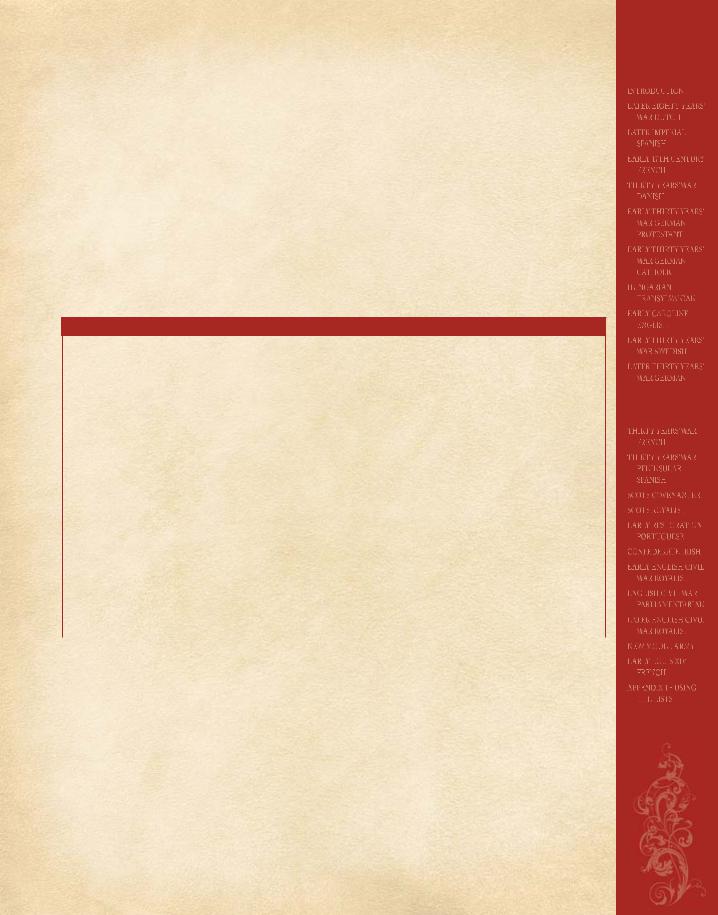
LATER THIRTY YEARS’ WAR SWEDISH AND WEIMARIAN
at least implies that Swedish cavalry (like other demi-cuirassiers) wore armour, it would appear that it came back into use, thus Armoured classification is allowed from 1640.
The defeat at Nördlingen all but destroyed the veteran Swedish and German infantry regiments of the two main Swedish armies. Their replacements no longer used the Swedish brigade system and the associated salvo shooting, instead using the same formations and tactics as most other foot of the time. With the emphasis on
marching, some regiments appear to have discarded their pikes as well as their armour. It was not until major Swedish foot levies were sent to Germany in 1638 that the Swedish element was again significant.
Whilst Commanded Shot were still used, this was no longer an automatic choice, as the cavalry was now at least as good as their enemies’, and commanders often preferred to allow them full manoeuvrability rather than slow them down with attached infantry.
LATER THIRTY YEARS’ WAR SWEDISH AND WEIMARIAN STARTER ARMY
Commander-in-Chief |
1 |
|
Field Commander |
|
Sub-Commanders |
2 |
|
2 x Troop Commander |
|
Swedish and German |
2 BGs |
Each comprising 4 bases of Swedish and German demi-cuirassiers: |
||
“demi-cuirassiers” |
Superior, Unarmoured, Determined Horse – Impact Pistol, Melee Pistol |
|||
|
|
|||
Swedish and German |
2 BGs |
Each comprising 4 bases of Swedish and German demi-cuirassiers: |
||
“demi-cuirassiers” |
Average, Unarmoured, Determined Horse – Impact Pistol, Melee Pistol |
|||
|
|
|||
German or Swedish |
|
|
6 bases of German or Swedish Infantry regiments: 2 Superior, Unarmoured, |
|
1 |
BG |
Heavy Foot – Pike; 4 Superior, Unarmoured, Medium Foot – Musket; and |
||
Infantry regiments |
||||
|
|
1 Superior Battalion Guns – Regimental Guns |
||
|
|
|
||
German or Swedish |
|
|
Each comprising 6 bases of German or Swedish Infantry regiments: |
|
2 |
BGs |
2 Average, Unarmoured, Heavy Foot – Pike; 4 Average, Unarmoured, |
||
Infantry regiments |
||||
|
|
Medium Foot – Musket |
||
|
|
|
||
Commanded shot |
1 |
BG |
2 bases of commanded shot: Average, Unarmoured, Medium Foot – Musket |
|
Dragoons |
1 |
BG |
3 bases of dragoons: Average, Unarmoured Dragoons – Musket |
|
12-pounder guns |
1 |
BG |
2 bases of 12-pounder guns: Average, Medium Artillery – Medium Artillery |
|
Camp |
1 |
|
Unfortified camp |
|
Total |
10 BGs |
Camp, 16 mounted bases, 25 foot bases, 3 commanders |
||
BUILDING A CUSTOMISED LIST
USING OUR ARMY POINTS
Choose an army based on the maxima and minima in the list below. The following special instructions apply to this army:
•Commanders should be depicted as demicuirassiers.
•Minima marked * only apply if any non-allied foot are used other than Musket only German infantry regiments and/or commanded shot.
•No more than half the Infantry Regiments fielded can be Superior.
•German and French allies may be fielded together, otherwise only one allied contingent may be fielded.
55
© Osprey Publishing ¥ www.ospreypublishing.com
LATER THIRTY YEARS’ WAR SWEDISH AND WEIMARIAN
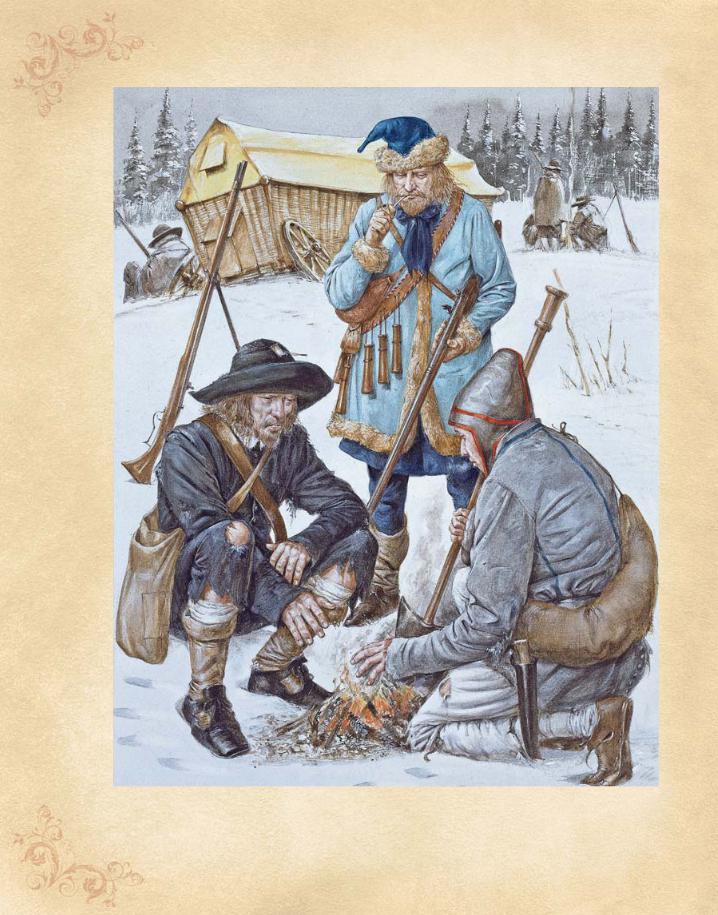
WARS OF RELIGION
Swedish infantry, 1635, by Richard Hook © Osprey Publishing Ltd. Taken from Men-at-Arms 235:
The Army of Gustavus Adolphus (1): Infantry.
56
© Osprey Publishing ¥ www.ospreypublishing.com
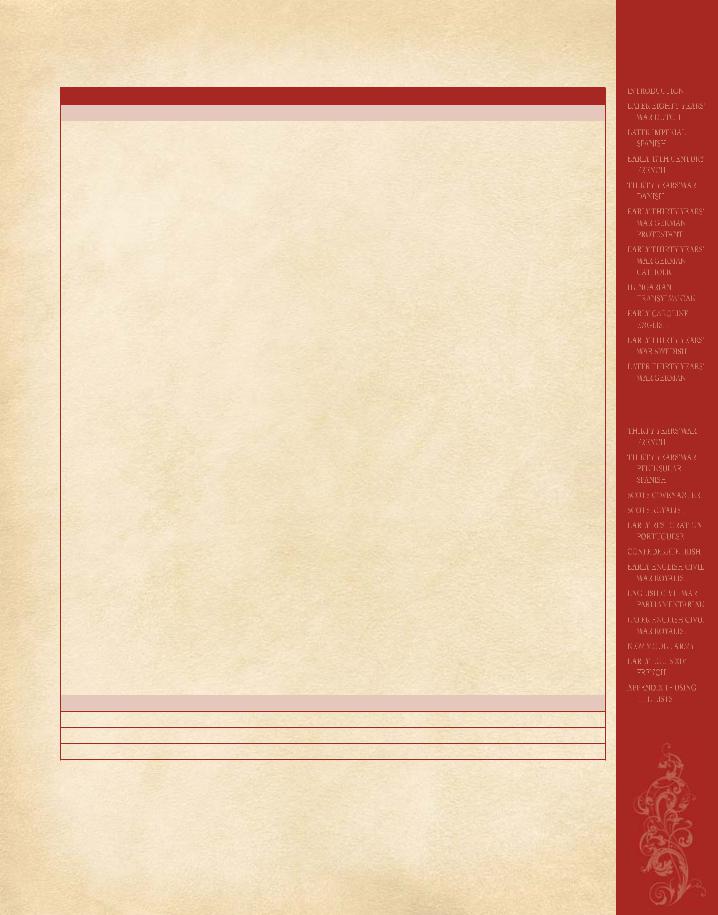
LATER THIRTY YEARS’ WAR SWEDISH AND WEIMARIAN
LATER THIRTY YEARS’ WAR SWEDISH AND WEIMARIAN
Territory Types: Agricultural, Woodlands, Hilly
C-in-C |
|
Great Commander/Field Commander/Troop Commander |
80/50/35 |
|
|
1 |
|
|||||||
Sub-commanders |
|
|
Field Commander |
|
|
50 |
|
0–2 |
||||||
|
|
Troop Commander |
|
|
35 |
|
0–3 |
|||||||
|
|
|
|
|
|
|
|
|||||||
Troop name |
|
|
Troop Type |
|
Capabilities |
|
Points |
Bases |
Total |
|||||
|
Type |
|
Armour |
Quality |
Shooting |
Impact |
Melee |
per base |
per BG |
bases |
||||
|
|
|
|
|||||||||||
|
|
|
|
|
|
Core Troops |
|
|
|
|
|
|
|
|
Swedish |
|
Any date |
Determined |
|
Unarmoured |
Superior |
– |
Pistol |
Pistol |
18 |
4 |
|
|
|
and |
|
Horse |
|
Average |
12 |
8–40 |
||||||||
German |
|
|
|
|
|
|
|
|
|
|
|
|
||
|
Only from |
Determined |
|
|
Superior |
|
|
|
21 |
|
|
|||
“demi- |
|
|
Armoured |
– |
Pistol |
Pistol |
4 |
|
|
|||||
|
|
Average |
15 |
|
|
|||||||||
cuirassiers” |
|
1640 |
Horse |
|
|
|
|
|
|
|
|
|
||
Dragoons |
|
|
Dragoons |
|
Unarmoured |
Average |
Musket |
– |
– |
8 |
3 or 4 |
3–8 |
||
|
|
|
Medium |
|
Unarmoured |
Superior |
Musket |
– |
– |
11 |
4 |
|
|
|
|
|
|
Foot |
|
6 |
0–18 |
|
|||||||
|
|
|
|
|
|
|
|
|
|
|
|
|||
|
|
|
Heavy Foot |
|
Unarmoured |
Superior |
– |
Pike |
Pike |
8 |
2 |
|
|
|
|
|
|
Medium |
|
Unarmoured |
Average |
Musket |
– |
– |
8 |
4 |
6 |
12– |
|
|
|
|
Foot |
|
|
|||||||||
German or Swedish |
|
|
|
|
|
|
|
|
|
|
48 |
|
||
Heavy Foot |
|
Unarmoured |
Average |
– |
Pike |
Pike |
5 |
2 |
|
|
||||
Infantry regiments |
|
|
|
|
|
|
|
|
|
|
|
|
||
Medium |
|
Unarmoured |
Poor |
Musket |
– |
– |
6 |
4 |
6 |
0–24 |
*12– |
|||
|
|
|
Foot |
|
|
|
|
|
|
|
|
48 |
||
|
|
|
Heavy Foot |
|
Unarmoured |
Poor |
– |
Pike |
Pike |
3 |
2 |
|
|
|
|
|
|
Medium |
|
Unarmoured |
Superior |
Musket |
– |
– |
10 |
6 |
0–12 |
|
|
|
|
|
Foot |
|
Average |
7 |
|
|||||||
French |
|
Only |
Medium |
|
Unarmoured |
Average |
Musket* |
Impact |
– |
8 |
4 |
|
|
|
Infantry |
|
Weimarians |
Foot |
|
Foot |
6 |
0–24 |
|
||||||
|
|
|
|
|
|
|
|
|
||||||
Regiments |
|
from 1637 |
Heavy Foot |
|
Unarmoured |
Average |
– |
Pike |
Pike |
5 |
2 |
|
|
|
|
|
|
Regimental |
|
|
Superior |
Regimental |
Regimental |
|
12 |
|
|
0–1 per |
|
Battalion guns |
|
– |
– |
n/a |
non-Poor |
|||||||||
Guns |
|
Average |
Guns |
Guns |
9 |
Infantry |
||||||||
|
|
|
|
|
|
|
|
|||||||
|
|
|
|
|
|
|
|
|
|
|
Regiment |
|||
|
|
|
|
|
|
|
|
|
|
|
|
|
||
Light artillery |
Light |
|
– |
Average |
Light |
– |
– |
12 |
2 |
|
|
|||
Artillery |
|
Artillery |
*2–4 |
|||||||||||
|
|
|
|
|
|
|
|
|
|
|
||||
Field artillery |
|
Medium |
|
– |
Average |
Medium |
– |
– |
20 |
2, 3 or |
||||
|
|
|
|
|||||||||||
|
Artillery |
|
Artillery |
4 |
|
|
||||||||
|
|
|
|
|
|
|
|
|
|
|
||||
|
|
|
|
|
|
Optional |
Troops |
|
|
|
|
|
|
|
Commanded shot |
Medium |
|
Unarmoured |
Average |
Musket |
– |
– |
8 |
2 |
0–8 |
||||
Foot |
|
|||||||||||||
|
|
|
|
|
|
|
|
|
|
|
|
|
|
|
Mercenary Bandellier |
Horse |
|
Unarmoured |
Average |
Carbine |
– |
Pistol |
9 |
4 |
0–8 |
||||
Reiter |
|
|
Poor |
7 |
||||||||||
|
|
|
|
|
|
|
|
|
|
|
||||
Allies
German Protestant allies – Later Thirty Years’ War German
French allies – Thirty Years’ War French
Transylvanian allies (only in 1644) – Hungarian–Transylvanian
57
© Osprey Publishing ¥ www.ospreypublishing.com
LATER THIRTY YEARS’ WAR SWEDISH AND WEIMARIAN
